|
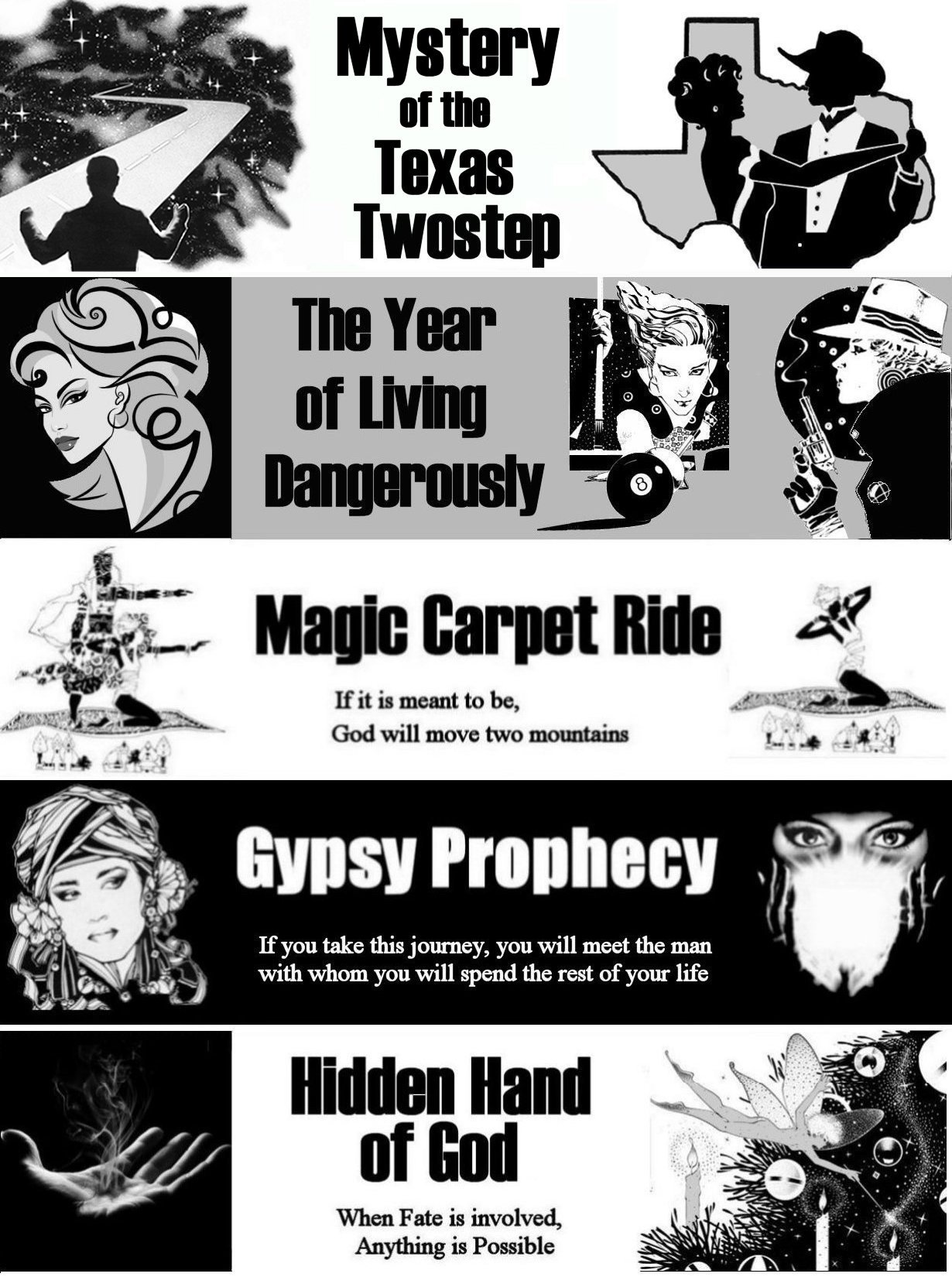
|
MYSTERY OF THE
TEXAS TWOSTEP
CHAPTER FOURTEEN:
FELKER'S DOWNFALL
Written by Rick
Archer
|
DARKEST DAY
AND BRIGHTEST DAY |
|
Rick
Archer's Note:
I am fond of an Arabic Proverb known as Two Days.
This proverb suggests that Life consists of alternating
cycles of Brightest Day-Darkest Day, Good Luck-Bad Luck.
When it is your Brightest Day, you can do no wrong.
When it is your Darkest Day, nothing seems to go right.
According
to this proverb, obstacles will be programmed into our life
and force us to deal with them.
My personal
belief is that 'Suffering' is part of life, but it
will not be limited to just one period. In my case, I
have identified six trips to Rock Bottom in my life.
The good news is that I always recovered. So the way I
see it, Life is divided into alternating cycles of ups and
downs.
Something I have
always found fascinating is how the Darkest Day principle
applies even to people who are truly gifted.
Some of the most famous people in history
seem to have had periods of their life where they really
struggled. One day I discovered a fascinating quote
made by J.K.
Rowling.
"Talent and intelligence will not inoculate anyone
against the Caprice of the Fates."
|
 |
To me, Ms. Rowling's
observation suggests that everyone is scheduled by Fate to experience
hardship at some point in their life. That includes those with money, privilege, talent,
and intelligence. That includes a powerful man like
Clay
Felker, the guy who seemed on top of the world.
In this
chapter we will see how Clay Felker hit Rock Bottom.
The
Arabic Proverb warns people to be careful during
their Brightest Day. "When Life is for you,
do not be proud or reckless."
It is my theory that Clay Felker ignored this advice.
During his climb to the pinnacle of his profession,
Felker began to take success for granted.
Flaunting his position, Felker rubbed certain
important people the wrong way. As consequence
to his reckless behavior, in 1976 Felker made two serious mistakes,
thereby initiating his Darkest Day. He too
proved vulnerable to the 'Caprice of the Fates'.
|
|
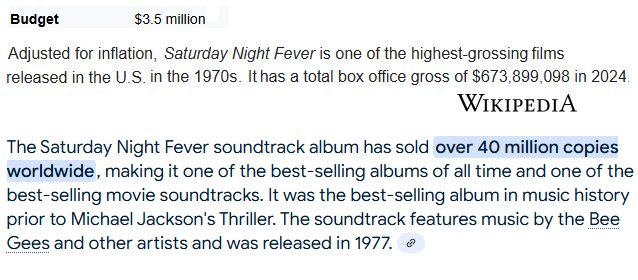
|
The moment
Robert Stigwood saw Nik Cohn's story in New York
magazine, he believed he had been handed the opportunity of
a lifetime. Well aware he had the right story, the
right actor, and the right music, Stigwood anticipated the
movie had the potential to make $100 million dollars.
Guess again. His movie made five times as much during
its initial release.
At the
time Saturday Night Fever made 500
MILLION Dollars
combined box office and soundtrack.
The soundtrack album kept selling and so did the
movie. Adjusted for
inflation, as of 2024 the movie generated a
box office close to $700,000,000. Considering the
movie's sound track is one of the largest selling albums in history
with 40 million copies sold, at a conservative price
of $10
we can assume it was worth at least another
$400,000,000. In other words, Saturday Night
Fever made A BILLION DOLLARS.
And how much did
it cost Robert Stigwood to make his Billion Dollar movie?
$3.5 million. Wow. Kudos to Stigwood. He
was smart to defy the skeptics and trust his intuition.
|
In 2007,
Sam Kashner penned a detailed 17-page, 10,000 word account of Saturday Night Fever. Kashner made it clear that
producer Robert Stigwood, actor John
Travolta, script writer Norman Wexler, and the three Bee Gee
brothers became wealthy and famous beyond their wildest
imaginations.
Another big winner was writer Nik Cohn. His name was listed prominently.
"So the deal [with
Stigwood] was made, and Nik Cohn was paid $90,000 for
the rights [to his story]."
Believe it or
not, Nik Cohn's lie became worth $500,000. Half a
million for a fake story. Amazing.
Sam
Kashner pointed out that Robert
Stigwood was not alone in recognizing the story's potential.
There were others.
"Back in the
70's it was almost unheard of to buy a magazine
article for a movie, but Cohn's 'Tribal Rites' attracted enough
attention that producer Ray Stark (Funny Girl) and a few
others bid on it."
In other words, all sorts of people noticed there was
something special about Nik Cohn's story.
However, one notable person
failed to notice anything interesting about the story.
Take a wild guess.
Considering
the thoroughness of Kashner's article, if Clay
Felker had been involved in the making of Saturday Night
Fever, we would assume his name would have appeared
as well.
Clay
Felker's name was nowhere to be seen.
For all the success tales that weaved through the improbable
Saturday Night Fever saga, try to picture Felker's
wounded pride when the movie proceeded
to become the cultural icon of the Seventies. Indeed,
the 'Ultimate trend spotter'
had
felt nothing but contempt for Cohn's story. So imagine
Felker's stupefaction when the story turned into a
national phenomenon.
Clay
Felker had wanted to cancel the story. He could not
put his finger on it, but there was something about Cohn's story that raised a red flag.
My guess is Felker smelled a rat. Like Robert
Stigwood, Felker should have trusted his intuition. However,
Felker's partner Milton Glaser persuaded him to
publish Cohn's story against his will.
The irony is
unbelievable. Without Felker's help, Cohn's scam
probably would
have never worked.
How
on earth could this brilliant man have missed this?
Wasn't Felker the man who could see the future? Not this
time. Despite his razor-sharp instincts for spotting unusual
lifestyles,
a story worth a billion
dollars passed right under his nose.
Casey at the Bat is a classic metaphor for the
dangers of complacency. With the game on the line, Mighty
Casey was so sure he would hit a home run that he didn't
even bother to swing at the first two pitches. Feeling
smug, Casey was shocked when he missed the third pitch.
Casey had struck out. The moral is to swing at every pitch because you might not get another chance.
However, if this happens to be your Darkest Day, sometimes
even the smartest guy in the room gets left holding his bat
on his shoulder. Clay Felker was the man who prided
himself in spotting trends before all others. And yet
the one time his talent could have really paid off, Felker
missed it.
Nik Cohn's scam was worth half a million.
Clay Felker never made a dime.
In simple terms, Clay Felker felt
exploited. He
had nothing to show for his contribution
but wounded pride.
|
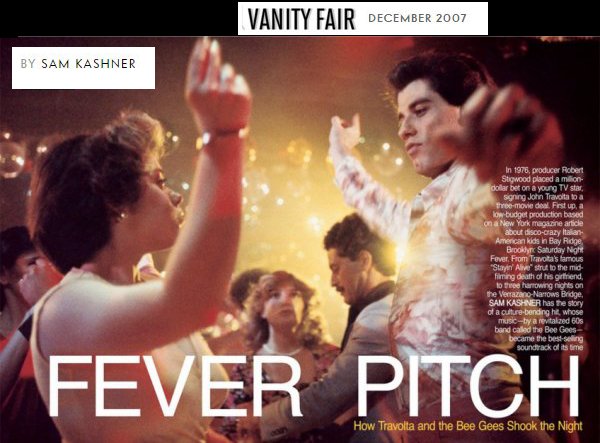
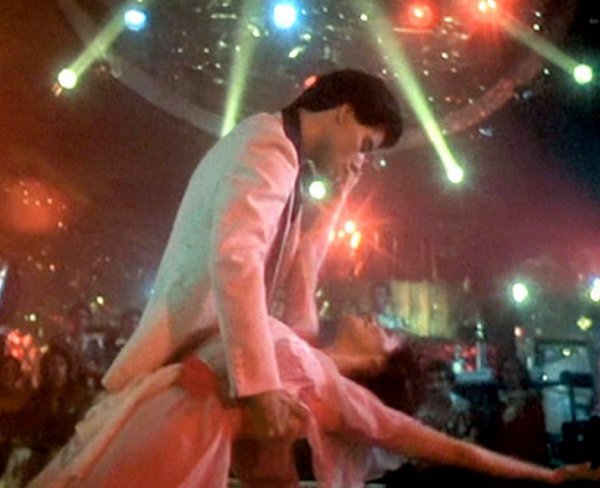
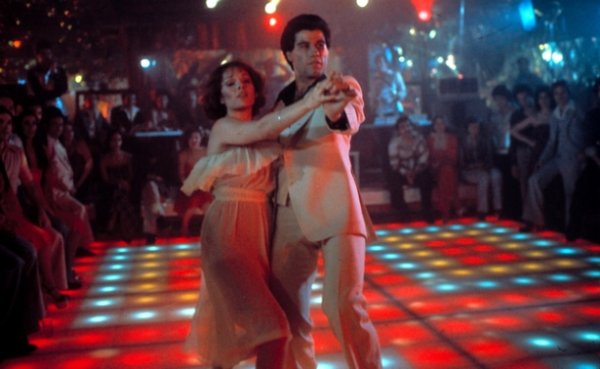
|
Barry
Gibb of the Bee Gees once said to Nik Cohn, "This is all your bloody
fault, isn’t it?"
Nik Cohn
just nodded.
By hoodwinking Clay Felker into giving
his story credibility, con man Nik
the Slik scored the
richest payday of his life.
Sometimes truth is stranger than fiction. A
throwaway B-movie designed to give an idle actor something
to do
turned into a Billion Dollar Bonanza. This all
happened because some English stiff made up a fairy tale and
sold it as truth.
Cohn agreed to accept
the first offer made by Stigwood's representative, $10,000. However, once
Felker published his story, Cohn was paid $90,000
for rights to his story. Despite the lucrative jump from $10,000, Cohn wasn't
satisfied.
In addition to the $90,000, Cohn demanded to write the
screenplay. Stigwood caved in and paid Cohn
$150,000 to write the screenplay.
Nik Cohn was not
done. He proceeded to negotiate percentage points
for the
soundtrack album.
This was unheard of. It had never been
done before. Musicians got
percentage points, but never a writer.
However, Cohn had
seen how much money The Who had made from the
Tommy soundtrack. Well aware he had his mark over a
barrel, Cohn took Stigwood to the
cleaners.
Once Cohn's share of the proceeds from the best-selling
soundtrack album rolled in, estimates placed the haul around
$250,000.
$90,000,
$150,000, $250,000. Incredible. Indeed, Nik Cohn
cleared somewhere in the ballpark of half a million for a
fake story. How did he pull this off? First, the
publication of Cohn's story in Felker's magazine dramatically
increased the credibility of the story. But the real
break came when Stigwood guessed the story was worth
$100 million.
Ironically, Nik the Slick was not as talented as
he thought he was. His movie script was rubbish.
It was so bad that Stigwood
was forced to bring in another writer, Norman Wexler, to
finish the job. We can assume Cohn's script went in
the wastebasket. Be that as it
may, Cohn's fake story had made him rich.
It was the scam of
the century.
|
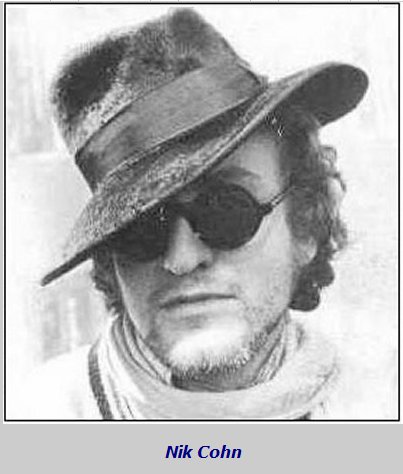 |
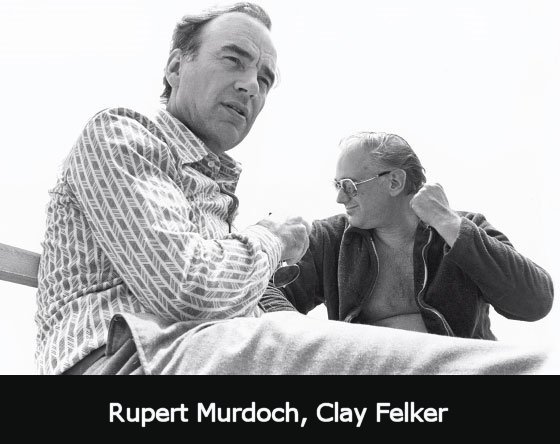 |
Simultaneous to
Nik Cohn's highway robbery,
Felker was in the fight of his life to maintain control of
his magazine.
Felker was up against a
ruthless billionaire named Rupert Murdoch. Making matters worse,
Felker's dilemma was a self-inflicted wound. It was
Felker's
own fault for letting the fox inside the henhouse.
Felker was a terrific
editor, but he had one major weakness... he liked to spend
other people's money. Felker's expenses were
so exorbitant, they out-stripped the magazine's resources.
His lavish spending on limousines, office space, costly
parties and personal
chefs drew heavy criticism from his magazine's board of directors.
One day Felker demanded they buy him a house in the
Hamptons so he could throw bigger parties. That was the last straw
for the magazine's Board of Directors. Clay Felker had
grown too big for his britches.
In 1976, New York was going broke. Fed up with
his
rampant spending, the Board told Felker to find a solution or start looking
for another job.
Felker did not
like being told to tighten his belt. No one talks to
him like that. Why not just buy the magazine himself?
Then he would have the last laugh. But first he had to
find a sugar daddy.
Clay Felker had recently been introduced to Australian media
mogul Rupert Murdoch by Katherine Graham, publisher of the
Washington Post. Graham had asked Felker to
show the city to the new kid in town. They lunched downtown and lounged seaside in
the Hamptons while discussing mutual business ventures.
In the process,
the two men became friends. Or so Felker thought.
|
Rupert Murdoch
was an Australian-born press baron who had just paid $30
million to add the New York Post to his chain
of newspapers in Australia, Britain and the United States.
Hoping to impress Murdoch, one day Felker invited his
so-called savior to visit one of his lavish parties.
No doubt Murdoch's eyes bulged as Felker guided a parade of
celebrities, businessmen and politicians over to meet him.
No doubt this was the moment Murdoch realized that Felker's
magazine could be of value to him.
Taking note of
Murdoch's deep pockets, in November 1976, Felker made a bold move.
He casually mentioned his boardroom
problems to his potential benefactor, then asked if Murdoch might be
interested in making an investment in the magazine.
Murdoch's eyes lit up immediately. Felker's suggestion was akin to asking the friendly
neighborhood fat boy to
watch his hot dog for a while. Thanks to Felker's big
mouth, Murdoch had just realized the smart, sophisticated New York magazine was not only in play,
it was exactly what he was looking for.
Licking
his
chops, Murdoch smiled
politely, then offered an invitation.
"Why,
sure, Clay, why don't you drop by my beach house this weekend?
Let's
have a talk!"
Felker must have been in some sort of fog. Or perhaps
he had fallen under the spell of 'Cosmic Blindness'.
You knew I was going to bring that up, didn't you? Ordinarily a shrewd man with killer instincts, Felker
had missed what Nik Cohn was up to. Now he missed what
Rupert Murdoch was up to as well. Felker did not seem
to understand that Murdoch was looking to
expand his media empire. That was why Murdoch had come to
New York in the first place. Murdoch had started with
the purchase of the New York Post,
a blue-collar tabloid. For his next conquest, he could
use this magazine as a way to court favor with the city's wealthy movers and shakers.
Meanwhile Felker remained blind to the danger. He was
so certain that Rupert Murdoch was a well-meaning buddy,
Felker poured his heart out to Murdoch during a fateful
weekend in the Hamptons. Journalist Susan Braudy
offered this startling eye-witness account:
|
"I had dinner with
Rupert and Clay
at
Murdoch’s rented house in Southampton. I was there
as a weekend houseguest of Clay Felker, the
publisher of New York magazine. Murdoch’s
daughter and son served steak and fresh baby peas. Flawlessly
tasteful. Intimate. A stealthy trap. For Murdoch, the
dinner party was a high-level espionage mission.
Clay had no
inkling that Murdoch was secretly positioning himself to
steal New York magazine out from under him. Clay was loquacious
throughout the meal. He explained Manhattan things to
Murdoch who Clay clearly saw as a bit of an Aussie rube. Clay
waxed eloquent about his writers Aaron Latham and Gail Sheehy who were
present at the meal. Clay explained my presence in
terms of Ms Magazine which he had helped
launch. This is where I wrote and edited.
Clay bragged about
his fabulous parties. He confided to
Murdoch that he got his best stories by listening to
dinner party conversation. He was oblivious to his
mistake. This time it was Murdoch who was doing the listening,
turning the tables so to speak. Clay got no stories
at this dinner because Murdoch said almost nothing. He
asked one or two flattering questions and that was it.
Murdoch was doing to Clay what Clay usually did to
everyone else... listen and think of ways to take
advantage.
A month or so
later, Murdoch seized New York magazine
and instantly fired Clay despite assurances to the
contrary."
|
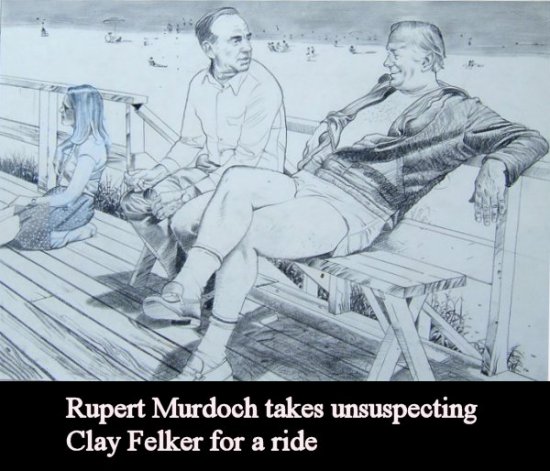 |
Clay Felker had been out of his mind to speak so candidly to
the fox.
Andrew Tobias, one of Felker's writers, had this say:
"Clay was not great with money.
He was always
asking me for financial advice like how he could stint on
his editorial package. Clay's bread and butter was
creativity. The stories, graphics and
writing meant far more to him than profits. Then
came the day he met a terrific young Australian
publishing tycoon. Clay told me, “Andrew, you’ve got to go meet this guy!”
Clay assumed he was setting up Murdoch to be
his shining knight. When Clay sent me over to visit Rupert Murdoch,
Murdoch ended up interviewing me about the magazine.
That's when I got that funny feeling. Sure enough,
to Clay’s
consternation, Murdoch grabbed the magazine right out from under him."
Once Murdoch realized Felker had alienated the board of
directors, he saw his opening. At the same time
Murdoch was sharing meals with Felker, he was negotiating
behind Felker's back with Carter Burden, the magazine's majority
shareholder.
According to the New York Times, Murdoch made a secret
offer to the board of directors to buy New York
magazine.
Clay Felker never saw it coming until it was too late.
Worried
he might lose his magazine, Felker asked Katharine Graham to
back him in a bid to keep the company.
When Graham learned of Murdoch's backdoor dealings, she
called Rupert Murdoch to beg him to reconsider.
“Don’t do this to the boy, Rupert. Don’t destroy this boy, don’t take this boy’s magazine from
him.”
Murdoch could have cared less, so Katherine Graham tried
another tactic. She
offered to buy out Carter Burden, the
principal stockholder, who held 24% of the stock.
That is when Felker's Karma came back to bite him in
the ass.
Carter Burden had once been the
subject of a highly unflattering profile in Felker's magazine.
Holding a grudge, Burden turned down Katherine Graham. On the
following day Murdoch flew to Sun Valley, Idaho, where
Burden was skiing. There on the sunny snow-covered
slopes, the two men made a deal.
Murdoch had sensed weakness. He was a shark and there
was blood in the water. Felker might be a great
editor, but he was a lousy businessman. Given how fed up
the Board was with Felker's spendthrift ways, all
Murdoch had to do was wave money and they took it. The moment Murdoch bought the
New York
magazine, he told Felker to hit the road.
Despite Felker's deep connection to his baby, Felker was of
no use to Murdoch.
A ship cannot have two captains.
Felker felt betrayed, stabbed in the back.
He had expected Murdoch would help him acquire
New York magazine,
not take it for himself. He had trusted the wrong person.
Felker was down to one last hope.
His stable of talented writers
was deeply loyal. They threatened to revolt
if Murdoch fired Felker. However, the writers got nowhere.
Murdoch called their bluff. If they left, Murdoch said
he would replace them
faster than the furniture, adding that there's always another
English major hungry to make their mark. Besides, try finding another job in
this market, especially after Murdoch put the hex on them. The revolt collapsed
faster than a punctured balloon.
Here is how Richard Reeves, one of Felker's stunned writers, put it:
"Part
of what happened was Carter Burden, who was majority
stockholder. Burden hated Clay because Clay hated
him. Clay had no use for people like Burden or the other
money people. He - mistakenly, I think - treated them
like dirt. Clay paid a heavy price for that
attitude.
[After Murdoch took over] this was a time that
we all thought the power was with the writers,
with the creative people. We were wrong. In a way we
were forced to learn what
they already knew in Hollywood: That’s not the way it is.
The power is with the money. While we wrote about
that all the time, and while Clay understood this fact
of life
intellectually, as a businessman I don’t think he got it.
That is what led to his downfall."
Gay
Talese, writer at Esquire:
"Power and the access to
power is a kind of addiction that sooner or later takes
over the brain waves of an editor.
Clay papered that house of his with personalities
and recognizable people, people who were going to fit
into his plan as writers, art directors, girlfriends, a
movie star. When I first
saw him was at a party with Sammy Davis Jr and Jacob
Javits and there were pretty girls abundant.
Being around so many important people, I think it went
to his head."
|
1976 and 1977 were tough years for Felker.
The toughest blow of all was losing his beloved
magazine. Once
Murdoch showed him the door, Felker was
heart-broken. He was also out of a job.
Humiliated, Felker
lost his pride,
his job,
and his magazine, the most precious thing in the
world to him. Felker had been synonymous with
New York magazine. But
not any more. Clay Felker was being called a loser, a
chump.
Felker had been outsmarted by Nik Cohn and outfoxed by Rupert
Murdoch.
No one but
Felker knew the inside story of how Nik Cohn had embarrassed him,
but the
Murdoch situation was different.
Felker's giant
reputation was badly tarnished when the news emerged about how
Murdoch had tricked him. Imagine what it must feel
like to become the laughingstock in the media capital of the
world.
People laughed at his downfall.
No doubt Felker was keenly aware that
his self-destructive behavior had gotten him into this fix.
What is Rule Number One when dealing with people who have
control of your Destiny? "Don't bite the hand that
feeds you." Felker was forced to acknowledge how
his unflattering profile of Carter Burden had led to his
destruction.
Brightest Day, Darkest Day. This was Felker's Darkest
Day.
Saturday Night Fever
was being filmed in Brooklyn at the same time that Clay
Felker was wrestling with Rupert Murdoch. Shortly
after Felker was fired in late 1977, the movie debuted in
December. At the exact moment
Clay Felker was thrown out on the street, he was forced to watch helplessly as
the box office and soundtrack made
Saturday Night Fever one of the most lucrative films in
cinematic history.
This had to be the lowest moment of his
life.
Everyone who touched this movie got
rich. Nik Cohn came away with half a million. Robert Stigwood made
more money than Midas. John Travolta and the Bee Gees rocketed to
stardom. Felker was aghast to realize he was the big loser
in this amazing bonanza. In particular, he seethed at
the indignity of letting Nik Cohn leapfrog to the
stratosphere using his unwitting shoulders for lift-off.
Feeling like a chump, it is fair
to assume Felker sought redemption.
Bitter
at his fate, Clay Felker decided he had a score to
settle.
So what was he going to do about it?
|
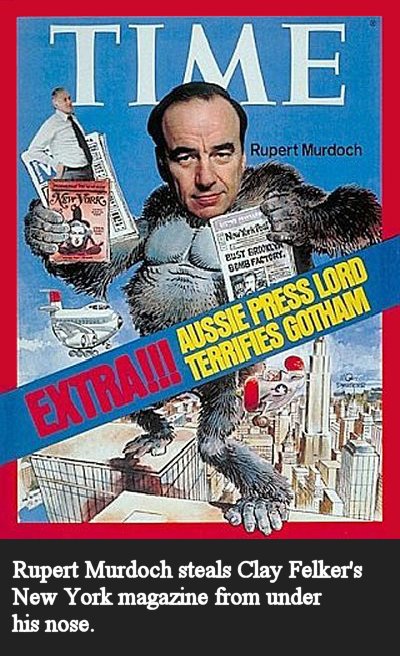 |
|
|